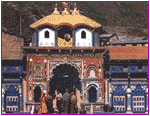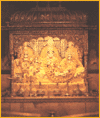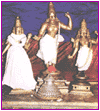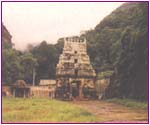About the Temple & Location :
Naimisaranyam is located at the junction of the roads from Sitapur
and Khairabad, 20 miles from Sitapur and 24 miles from the Sandila
railway station. 45 miles north of Lucknow in Uttarpradesh.
Naimisaranya is also known as “Nimsar” or “Nimkhar” and is located on
the left bank of the river Gomati.
Specials:
1. This kshetram is said to be one of the 8 swayam Vyaktha kshetrams. The other swayam Vyaktha kshetram are Sri Rangam, Srimushnam, Salagramam, Thotadri (Vaanamamalai), Tirupathi, Pushkaram and Badri.
2. This Naimisaranya kshetram is said to be regarded as “Tapovanam”. There are 9 tapovams. They are Dandakaranyam, Saindhavaranyam, Jambhukaranyam, Pushkararanyam, Utpalaranyam, Badrikaranyam, Gurujangalaranyam, Aruputharanyam and Naimisaranayam. It is belived that the perumal is found in the form of forest. And this Naimisaranyam is regarded as a holy forest.
Sthalapuranam
The Emperumaan of this sthalam is giving his seva as the entire form of the Vanam (forest).
In the old age, all the Maha Rishis along with Sownakar went towards Brahma devan and asked him which is the best place suited for doing Yagam and tapas. As the answer, Brahma devan took a dharbai grass and made it as a wheel shape and rolled the dharbai grass. Brahma devar said after he rolls the grass, the place where it stopped is said to be the ideal place for doing tapas and yagam. He rolled the wheel and it stops at a particular place in the Earth and that place is said to the place which is called as “Naimisaranyam”.
Nemi means a Wheel and Naimisam means the place where the wheel landed. Aaranyam means forest. Since Nemi, the Chakkaram which landed on Aaranya the forest, the sthalam is called as “Naimisaranyam”. This Naimisaranyam is said to be the place where most of the Rishis have done sacrifices, tapas and meditation and have explained the meaning of old puranas and veda.The Lord Emperumaan gives his seva as in the form of Nature. This sthala emperumaan, gives his seva with the name as “Sri Hari” along with Sri Hari Lakshmi and gave his audiance (prathyaksham) to Devendran, Sudharma, Devarishis, Soodhapuranika and Vedavyasa.
Once, Balarama, the brother of Sri Krishna came to this kshetram. At that time, Soodhar was very busy creating puranas. He didn’t notice the arrival of Balarama. On seeing this, Balarama got angry and hit him. He got into sin by committing this. To get out the sin, he went to lots of Punya kshetras for an year and finally he came back to this kshetram and help the rishis and yogis, who were suffering from the frightening of a arakkan (Demon) by named “Vilvalan”. All the rishis and yogis thanked Balarama for making them to perform austerities, tapas in peace to reach the Emperumaan.
Gayasooran, an Asura did tapas in this sthalam. Sriman Narayanan gave His audiance to him as he was fulfilled by his tapas. Sriman Narayanan asked him what boon he wants as a result of complete tapas. But, Gayasooran answered the Almighty, that he didn’t want any boon from him and he was so strong powerful than Sriman Narayana. On hearing this, Sriman Narayana sent his wheel (chakra) to kill the asura and his body was cut into 3 parts. The three parts are the Siro Gaya, (the head part), the Nambi Gaya (the middle part) and the Charana Gaya (the foot part). This sthalam, the Naimisaranyam is said to be the Nabhi Gaya. The Gaya Kshetram is said to be the Charana Gaya and Badri is said to be Siro Gaya. Offering prayers to departed souls in all these three sthalams is said to be so grateful.
The sthala viruksham, known as tree is Tapovanam and all the trees found in this sthalam are said to be sthala viruksham and because of this, the sthala viruksham is Tapovanam (Vanam means the entire forest).
The Pushkarani of this sthalam are Gomukhi Nadhi and Chakkara theertham. On the shore of Chakkara theertham, separate sannadhis for Chakarathalwar, Vinayaka, Sri Rama, Lakshmana and Seetha Piratti is located. On the way to Gomukhi Nadhi, a separate temple called as “Vyasa Ghat” is found. On the other side of this sthalam, a temple for Suka maharishi is situated, where Suka Bhagavan’s e bronze statue lies.
Near to this Suka Maharishi temple, a temple for Hanuman on the top of the mountains which is known as the “Hanuman Ghat”. He is in standing posture holding Sri Rama and Lakshmana in his two shoulders, in Vishwaroopa Kolam.
One of Ahobila Mutt Jeyer attained Paramapadham in this sthalam and as his rememberance, his sannadhi and a mutt of Ahobilam is opened in this sthalam. Ramanuja koodam, Vaanamamalai Jeeyar Mutt are also situated, helping the devotees who come to this sthalam to get the seva of this sthalam Emperumaan.
Thirumangai Alwar who is the only alwar who has done the Mangalasasanam on this sthala perumal explains about the life led by the human.
Moolavar:
The Moolavar of this Naimisaranyam Divyadesam is Devarajan. He is also named as “Sri Hari”. Moolavar in standing posture (Nindra thirukkolam) facing east direction. Prathyaksham for Indiran, Sudharman, Devarishi, Soodhapuranikar and Vedavyasar.Thaayar:
The thaayar of this Kshetram is Sri Hari Lakshmi. She is also named as “Pundareekavalli”.
Mangalasasanam:
Thirumangai Alwar who is the only alwar who has done the Mangalasasanam on this sthala perumal explains about the life led by the human.
Pushkarani:
Chakkara Theertham
Gomuki Nadhi
Nemi Theertham and
Divya Visrantha Theertham
Sthala Vruksham:
Tapovanam
Vimaanam:
Sri Hari Vimaanam.
Specials:
1. This kshetram is said to be one of the 8 swayam Vyaktha kshetrams. The other swayam Vyaktha kshetram are Sri Rangam, Srimushnam, Salagramam, Thotadri (Vaanamamalai), Tirupathi, Pushkaram and Badri.
2. This Naimisaranya kshetram is said to be regarded as “Tapovanam”. There are 9 tapovams. They are Dandakaranyam, Saindhavaranyam, Jambhukaranyam, Pushkararanyam, Utpalaranyam, Badrikaranyam, Gurujangalaranyam, Aruputharanyam and Naimisaranayam. It is belived that the perumal is found in the form of forest. And this Naimisaranyam is regarded as a holy forest.
Sthalapuranam
The Emperumaan of this sthalam is giving his seva as the entire form of the Vanam (forest).
In the old age, all the Maha Rishis along with Sownakar went towards Brahma devan and asked him which is the best place suited for doing Yagam and tapas. As the answer, Brahma devan took a dharbai grass and made it as a wheel shape and rolled the dharbai grass. Brahma devar said after he rolls the grass, the place where it stopped is said to be the ideal place for doing tapas and yagam. He rolled the wheel and it stops at a particular place in the Earth and that place is said to the place which is called as “Naimisaranyam”.
Nemi means a Wheel and Naimisam means the place where the wheel landed. Aaranyam means forest. Since Nemi, the Chakkaram which landed on Aaranya the forest, the sthalam is called as “Naimisaranyam”. This Naimisaranyam is said to be the place where most of the Rishis have done sacrifices, tapas and meditation and have explained the meaning of old puranas and veda.The Lord Emperumaan gives his seva as in the form of Nature. This sthala emperumaan, gives his seva with the name as “Sri Hari” along with Sri Hari Lakshmi and gave his audiance (prathyaksham) to Devendran, Sudharma, Devarishis, Soodhapuranika and Vedavyasa.
Once, Balarama, the brother of Sri Krishna came to this kshetram. At that time, Soodhar was very busy creating puranas. He didn’t notice the arrival of Balarama. On seeing this, Balarama got angry and hit him. He got into sin by committing this. To get out the sin, he went to lots of Punya kshetras for an year and finally he came back to this kshetram and help the rishis and yogis, who were suffering from the frightening of a arakkan (Demon) by named “Vilvalan”. All the rishis and yogis thanked Balarama for making them to perform austerities, tapas in peace to reach the Emperumaan.
Gayasooran, an Asura did tapas in this sthalam. Sriman Narayanan gave His audiance to him as he was fulfilled by his tapas. Sriman Narayanan asked him what boon he wants as a result of complete tapas. But, Gayasooran answered the Almighty, that he didn’t want any boon from him and he was so strong powerful than Sriman Narayana. On hearing this, Sriman Narayana sent his wheel (chakra) to kill the asura and his body was cut into 3 parts. The three parts are the Siro Gaya, (the head part), the Nambi Gaya (the middle part) and the Charana Gaya (the foot part). This sthalam, the Naimisaranyam is said to be the Nabhi Gaya. The Gaya Kshetram is said to be the Charana Gaya and Badri is said to be Siro Gaya. Offering prayers to departed souls in all these three sthalams is said to be so grateful.
The sthala viruksham, known as tree is Tapovanam and all the trees found in this sthalam are said to be sthala viruksham and because of this, the sthala viruksham is Tapovanam (Vanam means the entire forest).
The Pushkarani of this sthalam are Gomukhi Nadhi and Chakkara theertham. On the shore of Chakkara theertham, separate sannadhis for Chakarathalwar, Vinayaka, Sri Rama, Lakshmana and Seetha Piratti is located. On the way to Gomukhi Nadhi, a separate temple called as “Vyasa Ghat” is found. On the other side of this sthalam, a temple for Suka maharishi is situated, where Suka Bhagavan’s e bronze statue lies.
Near to this Suka Maharishi temple, a temple for Hanuman on the top of the mountains which is known as the “Hanuman Ghat”. He is in standing posture holding Sri Rama and Lakshmana in his two shoulders, in Vishwaroopa Kolam.
One of Ahobila Mutt Jeyer attained Paramapadham in this sthalam and as his rememberance, his sannadhi and a mutt of Ahobilam is opened in this sthalam. Ramanuja koodam, Vaanamamalai Jeeyar Mutt are also situated, helping the devotees who come to this sthalam to get the seva of this sthalam Emperumaan.
Thirumangai Alwar who is the only alwar who has done the Mangalasasanam on this sthala perumal explains about the life led by the human.
Moolavar:
The Moolavar of this Naimisaranyam Divyadesam is Devarajan. He is also named as “Sri Hari”. Moolavar in standing posture (Nindra thirukkolam) facing east direction. Prathyaksham for Indiran, Sudharman, Devarishi, Soodhapuranikar and Vedavyasar.Thaayar:
The thaayar of this Kshetram is Sri Hari Lakshmi. She is also named as “Pundareekavalli”.
Mangalasasanam:
Thirumangai Alwar who is the only alwar who has done the Mangalasasanam on this sthala perumal explains about the life led by the human.
Pushkarani:
Chakkara Theertham
Gomuki Nadhi
Nemi Theertham and
Divya Visrantha Theertham
Sthala Vruksham:
Tapovanam
Vimaanam:
Sri Hari Vimaanam.
 The Moolavar of this kshetram is Neelamega Perumal. He is also called with the name
"Purushothaman". He is giving his seva in Nindra thirukkolam facing his Thriumugam towards
east direction. Prathyaksham for Bharadwaja Maharishi.
The Moolavar of this kshetram is Neelamega Perumal. He is also called with the name
"Purushothaman". He is giving his seva in Nindra thirukkolam facing his Thriumugam towards
east direction. Prathyaksham for Bharadwaja Maharishi.
 1. This temple is opened only six months in a year, from mid of May to the third week of November.
But, it depends only upon the temple authorities. The temple is closed for next six months due
to heavy snow-fall in winter.
1. This temple is opened only six months in a year, from mid of May to the third week of November.
But, it depends only upon the temple authorities. The temple is closed for next six months due
to heavy snow-fall in winter.
 The Perumal, Badrin Narayanan explains all these 5 different things known as "Artha Panjaga
Gnanam". For a human, 5 relations are the most prominent one. They are Mother, Gather, Guru,
God and the pre generation peoples. In this, Guru is so important and it is non - equivalent
to anything. Without a proper guru, one cannot attain anything. So, the perumal here serves
as the guru and explain the Gnana to the world.
The Perumal, Badrin Narayanan explains all these 5 different things known as "Artha Panjaga
Gnanam". For a human, 5 relations are the most prominent one. They are Mother, Gather, Guru,
God and the pre generation peoples. In this, Guru is so important and it is non - equivalent
to anything. Without a proper guru, one cannot attain anything. So, the perumal here serves
as the guru and explain the Gnana to the world.
 From here, we can see the Ganga river originating. It is said that river Ganga originates from
the thiruvadi (feet) of Sri Vishnu. The Dwaram (the small entrance (or) hole) from where
the Ganga river originates is said to be Haridwar. People get this Ganga water closed in a
small vessel and take to their houses and keep them as sacred. Haridwar is called as
"Kapilasthan", because Kapila Munivar did the tapas here and worshipped Goddess Maya and
because of this, the place is also called as "Mayapuri". There are temples for Goddess
Manasa Devi, Chandi Devi, Maya Devi, Anjani Devi, Neeleshwarar, Dattatreyar, Navagrahas,
Mahadeva and Mrithyunjaya Mahadevar.
From here, we can see the Ganga river originating. It is said that river Ganga originates from
the thiruvadi (feet) of Sri Vishnu. The Dwaram (the small entrance (or) hole) from where
the Ganga river originates is said to be Haridwar. People get this Ganga water closed in a
small vessel and take to their houses and keep them as sacred. Haridwar is called as
"Kapilasthan", because Kapila Munivar did the tapas here and worshipped Goddess Maya and
because of this, the place is also called as "Mayapuri". There are temples for Goddess
Manasa Devi, Chandi Devi, Maya Devi, Anjani Devi, Neeleshwarar, Dattatreyar, Navagrahas,
Mahadeva and Mrithyunjaya Mahadevar.
 Next to Vishnu Prayag is a place called Hanuman Ghat where Lord Hanuman and Bheeman met
each other. Once, Bheeman thought he was the strong person in the world and was travelling
along this side. At that time, Hanuman laid there as a old monkey. Bheema say an old
monkey lying before him in the path and shouted at the monkey to give way for him. But, the
old monkey (Hanuman) told that since he is so weak, he could not able to move and told that
if Bheema could mvoe the tail, he can move it and go along with his way. Bheeman thought he
can move the tail with his one hand, but he could not do that. Using his full strength, he
tried, but he could not even move the tail for an inch. Finally, he thought, the old monkey
might be some Arakkan (or) Magic man. But finally, Anjaneyar showed his original Roopam and
explains him that there are brothers (since both are Vaayu Puthras). Bheema fell to the
feet of Sri Anjaneyar and asked that he should be along with them during the war against
the Gauravars (Duriyodhanan and his troop). Sri Anjaneyar told that he will be along with
them in the flag which is found on top of the Chariot of Arjuna.
Next to Vishnu Prayag is a place called Hanuman Ghat where Lord Hanuman and Bheeman met
each other. Once, Bheeman thought he was the strong person in the world and was travelling
along this side. At that time, Hanuman laid there as a old monkey. Bheema say an old
monkey lying before him in the path and shouted at the monkey to give way for him. But, the
old monkey (Hanuman) told that since he is so weak, he could not able to move and told that
if Bheema could mvoe the tail, he can move it and go along with his way. Bheeman thought he
can move the tail with his one hand, but he could not do that. Using his full strength, he
tried, but he could not even move the tail for an inch. Finally, he thought, the old monkey
might be some Arakkan (or) Magic man. But finally, Anjaneyar showed his original Roopam and
explains him that there are brothers (since both are Vaayu Puthras). Bheema fell to the
feet of Sri Anjaneyar and asked that he should be along with them during the war against
the Gauravars (Duriyodhanan and his troop). Sri Anjaneyar told that he will be along with
them in the flag which is found on top of the Chariot of Arjuna.

 The Moolavar of Ayodhya is Sri Ramar. He is also called with the names "Chakravarthy
Thirumagan", facing his thirumugham towards North direction. Prathyaksham for Bharadhan, all
Devars and Maharishis.
The Moolavar of Ayodhya is Sri Ramar. He is also called with the names "Chakravarthy
Thirumagan", facing his thirumugham towards North direction. Prathyaksham for Bharadhan, all
Devars and Maharishis.
 Brahmadevan did a strong tapas towards Sriman Narayanan. The perumal gave his prathyaksham
for Brahma and both of them hugged together. On seeing the great bhakti of Brahmadevan,
Sriman Narayanan is so emotionally attracted towards him and his (perumal) eyes started
to swell tears. But Brahma devan doesnt want the tears to let down it into the earth and he
collected all of his tears in the Kamandalam (a small vessel which all the Rishis have).
Using his power, Brahma devan created a pushkarani and all the drops of tears was mixed into
the pushkarani. And that is called the Maanasasaras in the Himalayas. Since, the theertham
is created along with the tears drops of perumal and the Manasika power (created from his
heart fulfilled) of Brahma devar, this theertham is so called as "Maanasasaras".
Brahmadevan did a strong tapas towards Sriman Narayanan. The perumal gave his prathyaksham
for Brahma and both of them hugged together. On seeing the great bhakti of Brahmadevan,
Sriman Narayanan is so emotionally attracted towards him and his (perumal) eyes started
to swell tears. But Brahma devan doesnt want the tears to let down it into the earth and he
collected all of his tears in the Kamandalam (a small vessel which all the Rishis have).
Using his power, Brahma devan created a pushkarani and all the drops of tears was mixed into
the pushkarani. And that is called the Maanasasaras in the Himalayas. Since, the theertham
is created along with the tears drops of perumal and the Manasika power (created from his
heart fulfilled) of Brahma devar, this theertham is so called as "Maanasasaras".
 Sri Ramar had two sons namely Lavan and Kusa. One day, Kusa was having a bath in Sarayu river
who was very much attracted by his beauty by Kumudavathi, a princess of Naga Lokam. she
wanted to marry him and because of this, she caught hold of Kusa's hands but she could not
stop him. After reaching the palace, kusa found his ornaments (bangle) was missing. He
thought it might have fallen in Sarayu river and to taken out the bangle from the river he
dried up the river using his astram. The Naga princes got frightened of the astram and
returned the bangle and falled to the feet of Kusa. Kusa explained the bangle was so
important since it was given by Vasistar to Sri Ramar, his father. And finally, Kusa let
the river to flow once again. Because of this, the theertham is called as
"Nageswara theertham".
Sri Ramar had two sons namely Lavan and Kusa. One day, Kusa was having a bath in Sarayu river
who was very much attracted by his beauty by Kumudavathi, a princess of Naga Lokam. she
wanted to marry him and because of this, she caught hold of Kusa's hands but she could not
stop him. After reaching the palace, kusa found his ornaments (bangle) was missing. He
thought it might have fallen in Sarayu river and to taken out the bangle from the river he
dried up the river using his astram. The Naga princes got frightened of the astram and
returned the bangle and falled to the feet of Kusa. Kusa explained the bangle was so
important since it was given by Vasistar to Sri Ramar, his father. And finally, Kusa let
the river to flow once again. Because of this, the theertham is called as
"Nageswara theertham".
 Ahobilam is situated at a distance of 74 Kms from Nandyal (Kurnool
District), around 365 Kms from Hyderabad and around 75 Kms from
Tirupathi. Lots of transportation facilities are available. Bus
facilities from Cuddapah, Nandyal and Banganapalli are available and
frequent.
Ahobilam is situated at a distance of 74 Kms from Nandyal (Kurnool
District), around 365 Kms from Hyderabad and around 75 Kms from
Tirupathi. Lots of transportation facilities are available. Bus
facilities from Cuddapah, Nandyal and Banganapalli are available and
frequent.



 Description:
The Tirupati Tirumala Devasthanam Temple is dedicated to Sri Vishnu as Srinivasa Perumal and Divine Mother Shakti as Padmavathi Thayar.
Description:
The Tirupati Tirumala Devasthanam Temple is dedicated to Sri Vishnu as Srinivasa Perumal and Divine Mother Shakti as Padmavathi Thayar.

 The Moolavar of this sthalam is Sri Aadhikesava Perumal. He is gound in Kidantha Thirukkolam in
Bhujanga sayanam facing his thirumugham along western direction. Prathyaksham for Chandiran,
the Moon God.
The Moolavar of this sthalam is Sri Aadhikesava Perumal. He is gound in Kidantha Thirukkolam in
Bhujanga sayanam facing his thirumugham along western direction. Prathyaksham for Chandiran,
the Moon God.
